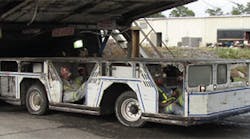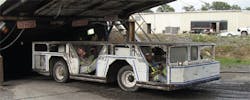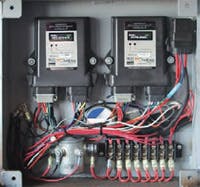Switch to hydrostatic transmission provides safer travel in mining vehicle
Underground safety is a high priority for today’s miners. Recently introduced personnel carriers – “man trips” in mining parlance – from Wallace Auto Parts & Service Inc., Raleigh, Ill., will make the daily commute far safer for many miners. Man trips are used to transport the miners and their equipment into and out of the mine in which they work. A typical ride to work might include driving down an incline to a level of 200 ft or more under the surface to the beginning of the mine shaft. From there they might travel four miles or more to the work face — in narrow, pitch black tunnels lit only by the lights from the man trip and helmet lamps.
Wallace builds diesel powered mining equipment, agricultural machinery and attachments, plus tilt utility trailers. A typical diesel utility vehicle (DUV) is only 8 to 9 ft wide to allow enough side clearance for driving in the 18 foot wide main and side corridors of the grid layout used in modern mining. That width doesn’t allow much margin for error when going around corners, so a shorter wheelbase vehicle provides a major advantage for mine navigation.
In the past, seat space in a man trip offered the same type of problems encountered while flying economy class on a sold out airplane. Couple closely placed seats with miners wearing safety belts, a cap lamp battery, self-rescue breathing apparatus for use in emergency, and a tool pouch with several specialized tools, and the result is extremely tight quarters at best.
Rugged individual seats were used in previous designs from Wallace, so miners had to keep themselves and their gear inside the allotted space. However, their legs, arms, heads, or tool pouches often extended outside the safety envelope as they attempted to gain more elbow room, which could cause injury from being hit by protruding objects if the vehicle veers too close.
Peabody Energy, St. Louis, the world’s largest private-sector coal company, approached Wallace to design a man trip that would provide a higher degree of safety for their employees. This safety initiative was driven by Peabody Energy’s Willow Lake Mine, which is close to Wallace’s plant. Wallace has long been known for innovation within the field — they supplied the first DUV approved for use by West Virginia. Today, the use of DUVs, including man trips from several manufacturers, is common throughout the coal mining industry. Thus, Wallace was a logical choice to take on the challenge.
The challenge posed to Wallace resulted in the Hydra-Drive man trip. Wallace’s Diesel/Mining Div. designed the Hydra-Drive family of man trips from the ground up with a view to improve both the safety and the comfort for the miners. The Hydra- Drive provides ample space for each miner and a much safer ride than previous machines. Hydraulics was chosen to run both propulsion and steering systems because it is more compact than other power transmission options, thereby allowing more space for miners.
Establishing goals
The Hydra-Drive man trip had to be designed from scratch because Peabody’s requirements were too extensive to permit modifying an existing machine. Peabody’s goals included:
- Reduce the weight of the vehicle to permit a shorter wheel base.
- Increase the average seating width per passenger inside the safety envelope.
- Limit the vehicle’s speed on grades to allow safe descent to the mine shaft.
- Create a smooth and consistent vehicle drive comparable to that of an automobile.
- Provide better visibility for the vehicle’s driver.
The first goal was accomplished by choosing a hydrostatic transmission (HST) (HST) and moving the engine to the rear. The drive shaft tunnel had occupied 8 in. of valuable seating space down the center of the car from the front-mounted engine to the rear axle. Weight saved by this change, along with others, allowed the wheelbase to be reduced from 148 in. to 107.
In addition to eliminating the drive shaft and drive shaft tunnel, designers also made the frame 10 in. wider. Older designs provide only 21 in. of seating width per miner, whereas the Hydra- Drive allows 25 in. on average.
Safe at any speed
Moving the engine to the rear of the vehicle gives the driver an unobstructed view to the side previously blocked by the engine placement. A screen mounted in the driver’s compartment displays the view from a high-resolution rear facing camera when backing up the 15,000 lb (fully loaded) vehicle.
Just like speeding on a highway is illegal and may result in a speeding ticket, speeding in a man trip is totally unacceptable in a mine. Uncontrolled speeds caused by careless operation or equipment failure — coupled with a sudden stop — could result in serious injuries or even death for miners. Therefore, the Hydra-drive has a speed limiting function whenever it encounters a downward slope greater than 6°. This is accomplished by routing output from an inclinometer to the machine's electronic controller to limit displacement of the hydrostatic transmission's pump.
The hydraulic system was designed and implemented by P. J. Baumeister, senior design engineer, and Alan Grotefendt, IFPS certified fluid power specialist, both of Engineered Sales Inc., Maryland Heights, Mo., a subsidiary of Applied Industrial Technologies. ESI took full system design responsibility. They selected a Divelbiss HEC-4000- E-R controller to monitor and control the HST and steering because of its flexibility for the application.
The HST provides independent rear-wheel drive through a pair of Eaton 72450 (2.48 in.3/rev) variable speed axial-piston motors. The drive is powered by an Eaton 46 series (4.6 in.3/rev) pump that is capable of 50 gpm flow at 2500 rpm. The variable displacement pump and variablespeed motors give the drive a wide range of operating speed and torque. Pump flow feeds an integrated hydraulic circuit manifold containing valves for providing limited-slip operation to the motors and positivetraction control (when needed) via a 50-50 flow divider. A separate circuit in the manifold scavenges charge pump flow and pressure for pilot control of the motors.
The electrohydraulic controller reads hydraulic pressure from a pressure transducer in the pump and engine speed. As the operator depresses the accelerator pedal, engine speed increases, which the controller detects and then sends a signal to electrohydraulic valves to ramp down displacement of the motors. The result is smooth and accurate acceleration, deceleration, and vehicle speed control. Smooth starting and stopping occurs even with the car on an incline and fully loaded.
As the vehicle travels, the controller continuously monitors pump pressure to ensure that pump torque remains within the optimum range of the engine. If the driver continues depressing the accelerator pedal, the controller increases pump displacement until a maximum speed is reached. Even though the vehicle can reach 20 mph, top speed is typically factory programmed for something less for safety reasons. If the vehicle encounters a downhill grade, hydrostatic pressure will drop, and the controller will decrease displacement of the pump. The pump then acts as a dynamic brake to keep the vehicle under a predetermined speed limit.
The program was written by Divelbiss staff to meet requirements established by the ESI team, which later made modifications in the field due to the ease of programming afforded by the Divelbiss EZ Ladder software.
Controller handles harsh conditions
Electronic control of Wallace Mining’s Hydra-Drive man trip is provided by a pair of HEC- 4210-E-R controllers from Divelbiss. The HEC-4000 series controllers feature an environmentally sealed, water-tight NEMA-4X enclosure, high speed counting, and CAN network communication with J1939. Based on the company’s PLC on a Chip technology, the controllers are easy to apply and program using the company’s EZ Ladder PC-based software. The controllers can be mounted directly onto machines and are especially well suited to mobile equipment.
Additional features include four digital inputs (two for highspeed counting), four analog inputs (0 to 20 mA or 0 to 5 V), six digital outputs (four configurable as PWM), selectable 8- or 16-bit PWM resolution, J-1939 and OptiCAN connectivity, visual status indicator, and output monitoring for overloaded or open circuits.
Intended applications include off-highway equipment, engine driven pumps, compressors and generators, proportional valves, and monitoring and control in remote locations.
For more information, contact the author at [email protected], or visit www.divelbiss.com.



